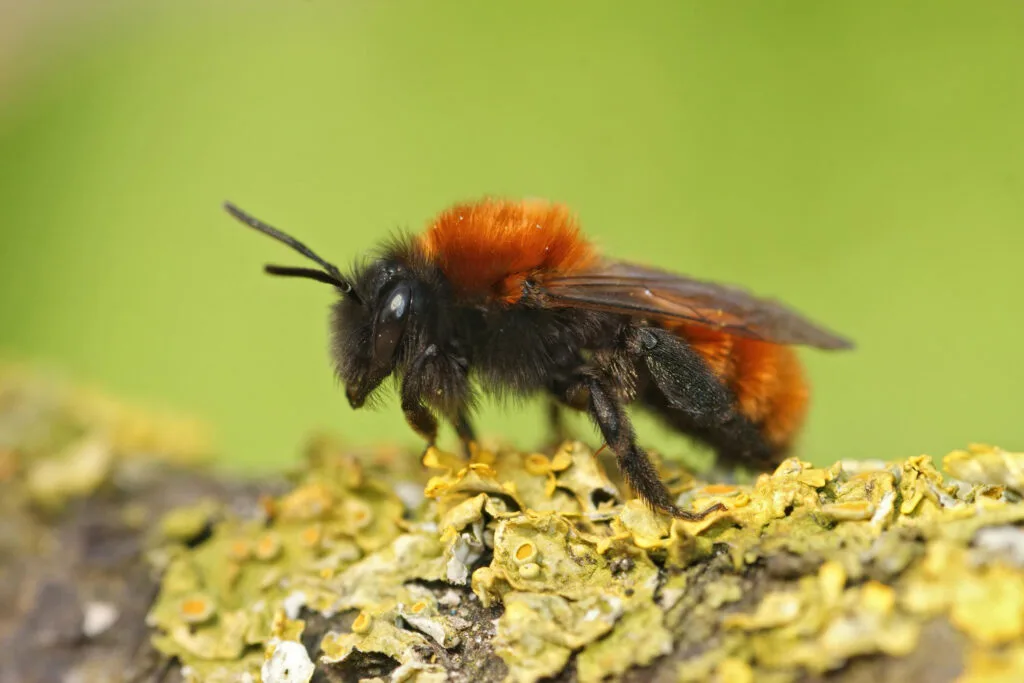Species Bombus Auricomus
Bombus Auricomus Black and Gold Bumble Bee, often known as the black-and-gold bumble bee, is a striking species found mainly in eastern North America, extending west into parts of the Great Plains. It thrives in open landscapes such as prairies, meadows, and gardens, and usually builds its nests close to the surface in grass clumps, under fallen logs, or in shallow cavities.
The queens are notably large, measuring around 22–25 mm, while workers and males are smaller. This species stands out for its bold black and golden-yellow patterning. As a versatile pollinator, Bombus auricomus feeds on a wide range of flowers including clovers, thistles, bergamot, monarda, and penstemons, playing a valuable role in maintaining both wild and cultivated ecosystems.
Unlike honeybees, the Bombus auricomus black and gold bumble bee forms seasonal colonies that last only a few months each year. Despite its short colony life, its pollination impact on wild and cultivated plants is significant.
Key Specifications of Bombus auricomus (Black and gold bumble bee)
| Specification | Details |
| Scientific Name | Bombus auricomus |
| Common Name | Bombus auricomus black and gold bumble bee |
| Family | Apidae |
| Size | Queen: 22–25 mm; Worker: 13–17 mm; Male: 14–18 mm |
| Appearance | Black body with yellow thorax bands and a golden tail |
| Habitat | North American prairies, meadows, open woodlands |
| Diet | Nectar and pollen from prairie wildflowers |
| Lifespan | Colonies last 3–4 months; queens live up to 1 year |
| Nesting | Abandoned rodent burrows, grassy tussocks, underground cavities |
| Behaviour | Social; forms annual colonies with one queen |
| Conservation Status | Near Threatened in some regions due to habitat loss |
Habitat & Behaviour
The Bombus auricomus (Black and gold bumble bee) thrives in prairies, meadows, and open woodlands across central and eastern North America. Preferring undisturbed grassy landscapes, it nests in abandoned rodent burrows or beneath clumps of grass. Colonies are typically small, with one queen and a few dozen to a few hundred workers.
A social species, the Bombus auricomus (Black and gold bumble bee) is active from spring through late summer. Workers forage within a 1–2 km range, ensuring effective pollination of native and cultivated plants.
Diet & Pollination Role
Feeding on nectar and pollen, the Bombus auricomus (Black and gold bumble bee) is a crucial pollinator for prairie wildflowers such as coneflowers, goldenrods, and milkweeds, as well as crops like tomatoes, peppers, and berries. Its long tongue and fuzzy body enable efficient pollen transfer, supporting both natural ecosystems and agriculture.
Life Cycle
The Bombus auricomus (Black and gold bumble bee) follows an annual life cycle. Overwintered queens emerge in spring to establish nests and lay eggs. Workers develop to forage and care for brood through summer. In late summer, new queens and males are produced; only the fertilised queens overwinter to start new colonies the next year.
Conservation & Threats
While not globally endangered, the Bombus auricomus (Black and gold bumble bee) faces regional population declines due to:
- Prairie habitat loss from agriculture and urbanisation.
- Pesticide exposure that harms pollinators.
- Climate change altering flowering cycles.
Conservation efforts include prairie restoration, pollinator-friendly planting, and pesticide reduction to safeguard the golden tailed bumblebee (bombus auricomus).
FAQs
Q1. Where is the Bombus auricomus (black and gold bumble bee) found?
The Golden Tailed Bumblebee (Bombus auricomus) inhabits central and eastern North American prairies, meadows, and open woodlands.
Q2.Bombus auricomus (black and gold bumble bee) are aggressive?
No. The Golden Tailed Bumblebee (Bombus auricomus) is generally non-aggressive and stings only when its nest is disturbed.
Q3. How Bombus auricomus (black and gold bumble bee) help agriculture?
By pollinating crops like tomatoes, peppers, and berries, the Golden Tailed Bumblebee (Bombus auricomus) boosts yields naturally.
Q4. How can I attract them to my garden?
Plant native wildflowers like coneflowers and milkweed, avoid pesticides, and provide grassy nesting spots for Golden Tailed Bumblebee (Bombus auricomus).
Q5. What is its conservation status of Bombus auricomus (black and gold bumble bee)?
It is listed as Near Threatened in some areas due to habitat loss and pesticide use.







